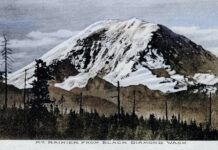In 1909 when this photo of his home appeared on a postcard, J.J. Smith was one of Enumclaw’s leading citizens. Within a year, the death of the esteemed doctor’s life shocked the community of Enumclaw. Built in 1904, the house still stands on the southeast corner of Myrtle Ave. and Marion Street. This view is to the southwest.
Born in West Virginia in 1869, John James Smith trained to become a doctor in Brooklyn, N.Y. He came west to Washington to become a company doctor in the coal mining town of Franklin near Green River Gorge. Dr. Smith arrived as labor strife broke out in May 1891. The mine’s owner, the Oregon Improvement Company recruited Blacks from the Midwest used to break strikes in several King County coal mining towns.Violence erupted, the governor called out the National Guard, and Dr. Smith was called to attend to injured victims before his medical equipment arrived. For one amputation, he had to use knives borrowed from the town’s butcher.
Smith ran for the State Legislature in 1899 and was elected, becoming its youngest member. He moved to Enumclaw in 1901 where he established his medical practice. That same year Smith advanced to the Senate and was reelected in 1902. At the start of that term, Smith was chosen President of the Senate by a unanimous vote. During the gubernatorial election of 1904, Smith’s name was put forward as a candidate but he withdrew from the race due to political complications.
In 1903, J.J. Smith married Selma Hanson, daughter of Carl Hanson a Swedish immigrant who had recently purchased the White River Lumber Company. He was also a co-founder of the town’s first bank which eventually became the First National Bank of Enumclaw. Smith was actively involved in community affairs, particularly education spearheading the building of a new school two blocks west of his home. At age 41, Dr. Smith traveled to Yakima to promote a Naches Pass highway connection to Enumclaw. He contracted typhoid fever at a café and died suddenly on Nov. 12, 1910. The three-story brick school just built at the corner of Fell Street and Griffin Avenue was renamed in his honor. When that building was torn down and a new elementary school was built in 1957, it too bore the name, J.J. Smith School.
From the 1960s and for over 50 subsequent years, J.J. Smith’s home belonged to the Rex and Una Waldron family. Coincidentally, J.J.’s only son, Rufus Smith lived next door. As to other buildings in this photo, the home to the left was built by Louis Olson, a teamster for the White River Lumber Company who married Ellen Hanson becoming J.J. Smith’s brother-in-law. The architecture of the two homes is similar as they were constructed by the same builder, Claude Hause. The Olson home at 1513 Griffin was for many years the residence of Phil & Mary Beige and since 2008 has been owned by the former NBA star, Brian Scalabrine.
The home at 1514 Griffin, on the left edge of this photo was built by Charles and Jennie (Wickersham) Hanson, another brother-in-law of J.J. Smith. Charles was in charge of White River’s planning mill. Their home was built in 1901 and was converted into apartments likely in the 1950s. The steeple seen just left of Smith’s porch was that of the Danish Evangelical Lutheran Church, built in 1899. It still stands on Griffin Ave., although it’s now a private residence.
This postcard image comes courtesy of JoAnne Matsumura, an Issaquah historian and photo collector. Reid Peterson of the Enumclaw Plateau Historical Society provided some background information.







